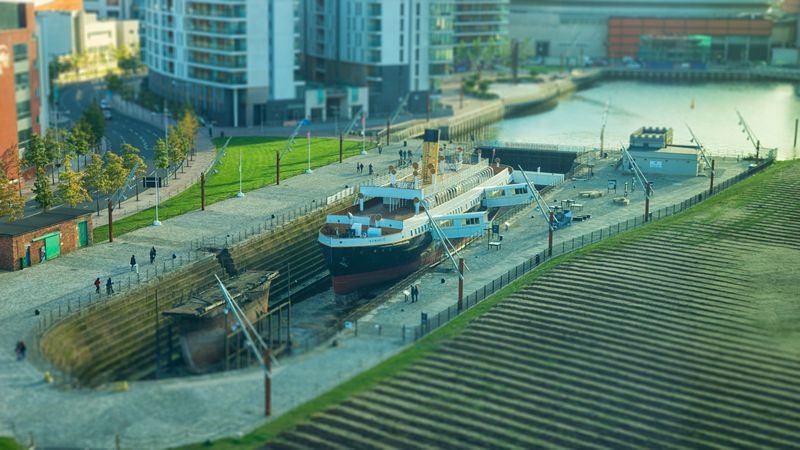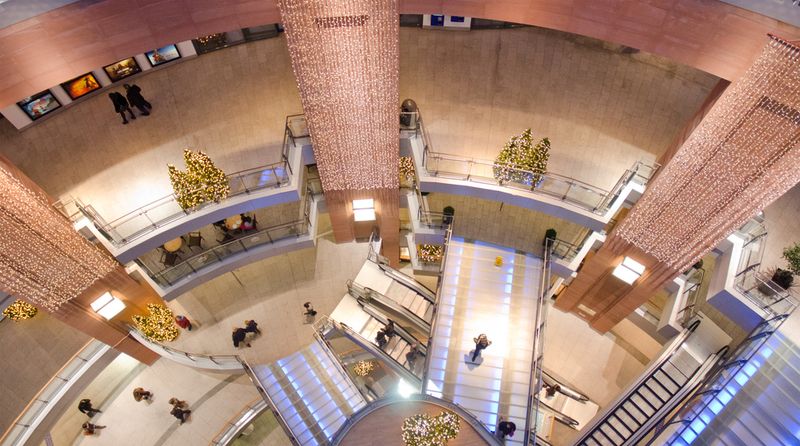
Belfast is the capital city of and the largest city of Northern Ireland and is the second largest city on the island of Ireland. During the period of conflict called “the troubles”, Belfast suffered greatly, but has since sustained a period of calm, free from the political violence of the past and has experienced substantial economic and commercial growth. There are many things to see and do in Belfast for all ages. Because of its rich history in shipbuilding, there are many sites where you can explore the history. For example, you can see where the famous “Titanic” was built or visit the SS Nomadic. If you would like to experience a little culture, a visit to the Grand Opera House should be on your itinerary. Maybe you’d like to visit a castle, take a walk through a park or possibly take the family to a zoo. Whatever your preference, you’ll find it in Belfast.
Advertisement
1. Grand Opera House
Opened in 1895, the Grand Opera House is a theater located in Belfast and is the premier theater in Northern Ireland. Their programming includes drama, dance, opera, comedy, musicals and family shows, so its perfect for whatever your taste in theater genre. The goal of the theater is to present world-class entertainment while remaining self-sustaining and to ensure that your experience is enjoyable whether you are watching a show or working at the theater. Some of the shows currently being hosted at the Grand Opera House include: Family – Horrible Histories, The Cat in the Hat, Singalonga Frozen, Snow White, and Mister Maker; Drama – The Business of Murder, The Lord of the Flies, and The Curious Incident of the Dog in the Night-Time; Comedy – One Night in Istanbul, Mama Mia It’s Murder, Hypnotic Dinner Show, Del and Rodney – The Dinner Show, Jason Byrne, Carry On Screaming – The Comedy Dinner Show, and Give My Head Peace. There are many more shows and events always happening at the theater. Don’t miss out on a great experience.

2. SS Nomadic
First launched on April 25, 1911, the SS Nomadic is the only surviving White Star Line steamship today. It is 230 feet (70m) long and 37 feet (11m) wide with a registered weight of 1,273 tons, had two single ended coal fired boilers and two compound steam engines, each driving two three-bladed screws of 7 feet (2.1m) in diameter with a maximum speed capacity of 12 knots (14 mph/22 km/h). With four working decks, the Nomadic could carry up to 1000 passengers when fully loaded. In 2006, the Nomadic Preservation Society was formed to preserve the SS Nomadic and publicize it as a tourist attraction. She now sits in Belfast’s Hamilton Dock where visitors can climb aboard and experience the history of over 100 years of authentic maritime and social history. Known as the mini Titanic, the Nomadic’s four decks let you experience first hand how it felt to be a passenger aboard the Titanic on her fateful maiden voyage. The story of the Nomadic is told in various interactive manners; hands on, technical and traditional storytelling that appears to all ages.

3. Cavehill
Overlooking Belfast, Cave Hill sometimes spelled Cavehill is a basaltic hill that forms part of the southeastern border of the Antrim Plateau. One of its most distinguishing features is a basaltic outcrop resembling the profile of Napoleon Bonaparte. Historically it was known as Ben Madigan, meaning “Madigan’s Peak” after the king of Ulster, Madigan who died in 856 AD. From the peak, you can see all of Belfast as well as the Isle of Man and Scotland on a clear day. Cave Hill is thought to be the inspiration for the story, Gulliver’s Travels because Swift imagined the hill resembled a sleeping giant safeguarding the city. There are three large caves with the lowest being 21 feet (6.4m) long, 18 feet (5.5m) wide varying from seven to 10 feet (3.0m) high. Above that is another cave measuring 10 feet (3.0m) long, seven feet (2.1m) wide and six feet (1.8m) in height. Over that is the third major cave said to be divided in two unequal parts larger than the other two, but few venture there because it is notoriously treacherous in its descent. You can explore the caves and then visit McArt’s Fort at the summit of the hill.

4. Belfast Zoo
The Belfast Zoo, also known as Belfast Zoological Gardens or Bellevue Zoo, is a zoo located in a secluded location on the northeastern slope of Cavehill overlooking Belfast’s Antrim Road. Its location results in a very tranquil setting for the animals – something the zoo is often praised for. As one of the top fee-paying visitor attractions, the zoo receives more than 300,000 visitors per year. The zoo covers 55 acres (22 ha) and is home to over 1,200 animals and 140 species. Many of the animals that live here, are threatened in their own natural habitats, so the zoo offers a safe haven for their species. Some of the animals you will see include Barbary lions, red kangaroos, spider monkeys, Moloch gibbons, Rothschild’s giraffes, Asian elephants and Malayan sun bears. One area of the zoo called the Bird Park, houses many exotic and endangered birds like the blue-bellied rollers, hornbills and white-crested turacos. The giraffe and elephant enclosure is home to a large herd of Rothschild’s giraffes. Don’t forget to visit the Rainforest House, a tropical rainforest housing 20 Rodrigues fruit bats, Fulvous whistling ducks, Nicobar pigeons and greater necklaced laughingthrush. Tons of fun for everyone.

Advertisement
5. Belfast Castle Estate
Located on the slopes of Cavehill Country Park, Belfast Castle Estate sits prominently at 400 feet (120m) above sea level and provides an unobstructed view of the city of Belfast below and Belfast Lough. Located inside the castle is The Cellar Restaurant which serves light snacks, refreshments and lunch as well as a traditional Sunday lunch. The Belfast Castle Estate is included as part of the Cavehill landmark with its five caves located on the side of the cliffs. It’s a wonderful natural attraction with its rich archaeological and historical features. The Cavehill Visitor Centre is located in the basement of the castle and admission to this wonderful museum is absolutely free. Don’t miss out on this great piece of Northern Ireland and its intriguing history. It’s a wonderful place to not only see incredible architecture, but also climb and explore the caves and see the spectacular view from the summit.

6. Ulster Museum
Located in the Botanic Gardens, the Ulster Museum is around 8,000 square meters of public space displaying collections of fine and applied arts, archaeology, ethnography, treasures from the Spanish Armada, local history, numismatics, industrial archaeology, botany, zoology and geology. It is the largest museum in Northern Ireland. The museum houses many important exhibits pertinent to the area. Some of which are Irish birds, mammals, insects, molluscs, marine invertebrates, flowering plants, algae and lichens and also includes an archive of books and manuscripts on Irish natural history. Along with a collection of rocks, minerals and fossils, there is a small dinosaur exhibit which has been scaled down from a larger collection. You can explore the zoological collections both historic and recent. There are individual specimens of all kinds of animals important to the area, wildlife art by some of the world’s most renowned artists, and botany in the Herbarium. It’s a magnificent collection which will be of interest to just about anyone interested in various aspects of Irish history.

7. Belfast City Hall
Belfast City Hall is the civic building of city council located in Donegall Square dividing the commercial and business areas of the city centre. The site where it now stands was once the home to White Linen Hall, in the middle of Linen Quarter and Linenhall Street. The beauty of the architecture is reflected in the fact that city hall in Durban, South Africa is almost an exact duplicate of Belfast City Hall and was designed by Stanley G. Hudson who was inspired by the design. The exterior of the building consists of mostly Portland stone and is in the Baroque Revival style. It features towers at each of its four corners and has a lantern-crowned copper dome in the center making it a bright green color. The interior is quite majestic with its Grand Entrance and The Porte-Cochere, The Grand Staircase, The Reception Room, and the Great Hall. The grounds surrounding city hall are no less beautiful and is a popular spot for workers to sit during their lunch and tourists to go to soak up some sun and ambiance.

8. Titanic Quarter
Located in Belfast in Northern Ireland, Titanic Quarter is a large-scale waterfront regeneration project consisting of historic maritime landmarks, film studios, education facilities, apartments, the riverside entertainment district and the world’s largest Titanic-themed attraction centered on land known as Queen’s Island until 1995. The Titanic Belfast visitor attraction which opened March 31, 2012, is the largest development in the Quarter holding the record for the largest single concrete pour ever (4,300 cubic meters) for its foundations. Northern Ireland Science Park is a hi-tech science park that opened in 2005 and was used in some film productions such as Game of Thrones and City of Ember. In 2011, Belfast Institute for Further and Higher Education relocated its facilities to the Titanic Quarter and changed their name to Belfast Metropolitan College. In 2009, Belfast Harbour Marina opened in the center of the Quarter as part of the Belfast Tall Ships Festival. The first hotel, Premier Inn, opened in November 2010 and featured 120 bedrooms and an onsite restaurant. Also in November 2010, 115 new jobs were created when Belfast Audi opened for business. The Titanic Quarter is rich with architectural marvels and interesting historical sites to see. The views here are incredible.

9. Victoria Square Shopping Centre
Built over a six year period, the Victoria Square Shopping Centre is a commercial, residential and leisure development consisting of approximately 800,000 feet2 (75,000 m2) and is the biggest and one of the most expensive property developments ever built in Northern Ireland. The shopping centre has two covered multi-level streets linked to a massive glass dome measuring 35 meters in diameter. The hub of the entire area is a public square entirely covered by the glass dome. There is a Jaffe Fountain located in Victoria Square which is ornately stunning to see. There are 17 contextually differing buildings joined by pedestrian links that stretch on to other businesses, nightlife and shopping streets. You will find everything here in one convenient location. In the shopping centre you’ll find stores for fashion, health and beauty, home entertainment and electronics, home furnishings and decor, and many other retail stores. There are also plenty of choices for dining whether you just want a quick snack or sit down and have a meal.

Advertisement
10. Kelly’s Cellars
You can’t have the Irish experience without visiting one of the Irish Pubs to be found in Belfast. One notable pub is Kelly’s Cellars located at 30 Bank Street, right in the city centre. There you can enjoy traditional pub food and music sessions in an old-fashioned atmosphere with vaulted ceilings and an elbow-worn bar crammed with all kinds of bric-a-brac. Built in 1720, it is the oldest licensed premises in Belfast and displays a blue plaque on the site erected by the Ulster History Circle stating the Society of United Irishmen met there from 1791 to 1798. Once you are done all your sightseeing and exploring around Belfast, there is no better way to unwind than to visit an Irish pub for a pint. The atmosphere at Kelly’s Cellars fits the mold perfectly with its historic building, decor, old-fashioned service and friendly patrons and staff. The beer is top notch as is the service, the music is excellent and you’ll have a great time mixing it up with people of different ages and personalities.

Advertisement